Daniel Fisher has been guiding the Maria Island Walk for the past eight years. We were able to chat with him recently to find out what he loves about being a wildlife guide and life on Maria Island.
How did you get involved with The Maria Island Walk?
I moved from Western Australia, more than eight years ago. I had heard about a guiding course that you can do around Australia - it's really well supported by the tourism industry and puts you in touch with operators like The Maria Island Walk. I came over here from Perth as part of that course, and I found The Maria Island Walk - and I thought "yeah, this is the place!"
What do you enjoy most about being a wildlife guide with The Maria Island Walk?
When you get to spend an extended amount of time on the island, you get to watch things change over and over again. People think that you’re doing the same walk over and over again, but you’re actually watching a big cycle. No tour that we do is the same. There is always something different happening. I do love the reactions of our international visitors. Most of all, it really is such a special place for wildlife!
What kind of reactions do you see?
They come from when you’re dealing with species like a Kookaburra. When they hear a Kookaburra ‘laugh’, you see so much confusion, like "what is that? Is that a Monkey?"
Also the setting evokes such an amazing reaction from visitors. A section of the island was set up as a farming community and industrial state. The way the hills roll in with the ocean behind them and the animals grazing on these vast paddocks (fields), it's really quite gentle on the eyes and something beautiful to watch. People just seem to relax and sort of slump into their chairs. It’s great for really busy people to be able to visit and just relax.
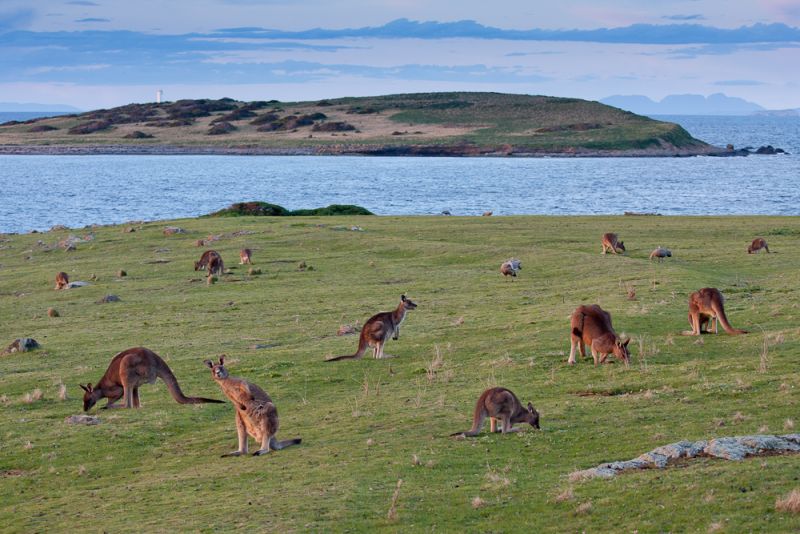
Image: Eastern Grey Kangaroos grazing in the open grasslands of Maria Island.
What were some of the highlights of the recently-completed walking season?
We had a large Fur Seal washed up on the beach, unfortunately deceased. With the Tasmanian Devils around, we literally got to see a huge (few hundred-kilo) carcass stripped overnight. We watched this Fur Seal slowly getting gnawed down. During the day, it's very unusual to see the Devils, but some of the smaller ones, the real 'juniors' are slightly more confident. They come out during the day and we see those during our walks. The ‘Devil Team’ (conservation team helping the endangered Tasmanian devils) has gone to great efforts to keep them wild.
This year we had a great Swift Parrot migration. The blue gums generally only flower every five years - and this was one of those years. On the Isthmus (the sandy bar between the two main islands), the growth of all of the trees is really stunted as they're growing in sand. This means that the flowering happens at eye-level. This is where one of our camps is, so we literally sat there and watched these Swift Parrots come in and feed in huge numbers! They're one of Australia's rarest birds at the moment, so this was pretty special!
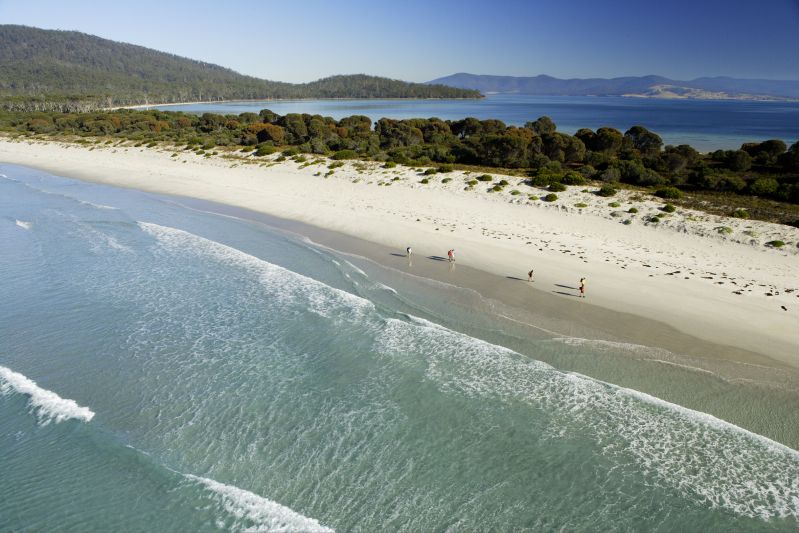
Image: McRaes Isthmus provides a stunning bridge between the two main islands.
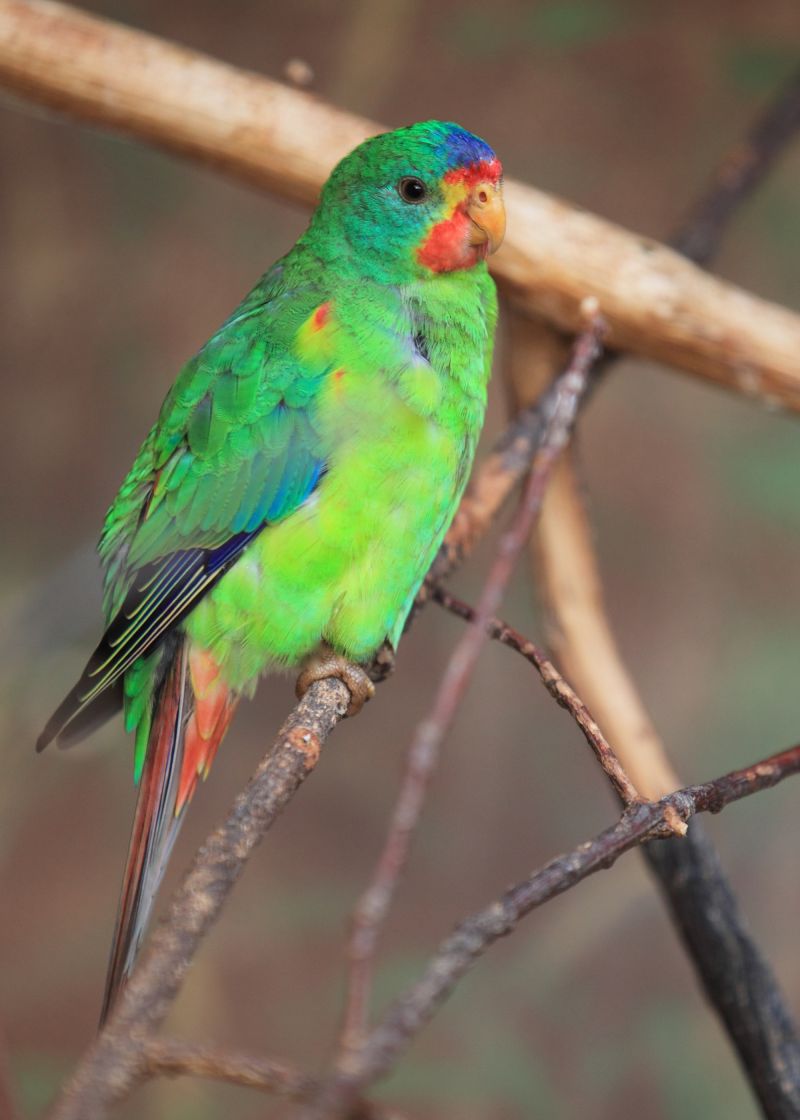
Image: The endangered Swift Parrot
With the Maria Island Winter Escape resuming for its third year, what do you think are the benefits of visiting Maria Island in winter?
Maria Island was set up as a wildlife reserve. People and animals have been interacting peacefully for the last forty odd years, so the wildlife we see, even though they are wild, are not afraid us. They don't just bolt as soon as they see us because habituation has occurred.
We do manage to get reasonably close without disturbing their natural behaviour, so we get to watch them do their 'thing' naturally, without them being tame. The southern part of the island has very little visitation, so it's actually still quite a wild place to visit.
We'll come across things like Boobook and Masked Owls in the evening. Night time is when a lot of activity happens - you might see some Kangaroos during the day, but at night time when you're out in the bush, that's when you have the chance of seeing Potoroos, Bettongs as well as nocturnal birds such as the owls.
So the Winter Escape to me is a fantastic time to visit the Island - you're very likely to have the entire island just to your group. There might just be some park rangers around, but you're going to have these amazing places we visit, all to yourself - and you'll be able to spend as much time as you wish there. Also in winter, you'll be seeing blue skies - it's a great time of year for visibility. You can see a lot further on a cold, clear day than on a summer's day. This is also the right time to see the whales that are starting to return on the east coast.
So, there are a number of reasons to visit in winter!

Image: Maria Island with mainland Tasmania to the south and west.
What are the most common wildlife encounters guests should expect?
You'll get sick of wombats! The first one you see will be amazing - but there will be wombats everywhere and they don't seem to have a particular breeding season, so there are always a few pouch joeys on the go.
In the south, that's where we always have a few White-bellied Sea Eagles that nest somewhere near our camp. The Hooded Plovers along the beach, they're really awesome!
Then we'll reach Kangaroo country - we'll see the Forester Kangaroos. A big mob hang out there, including a couple of big males.
As we're walking through the isthmus, we'll see Beautiful Firetails and White-fronted Chats, which are pretty rare to see. Musk Lorikeets and the Green Rosellas - they're everywhere, they're gorgeous birds.
Oh - and the Devils - the Devils are probably a highlight!
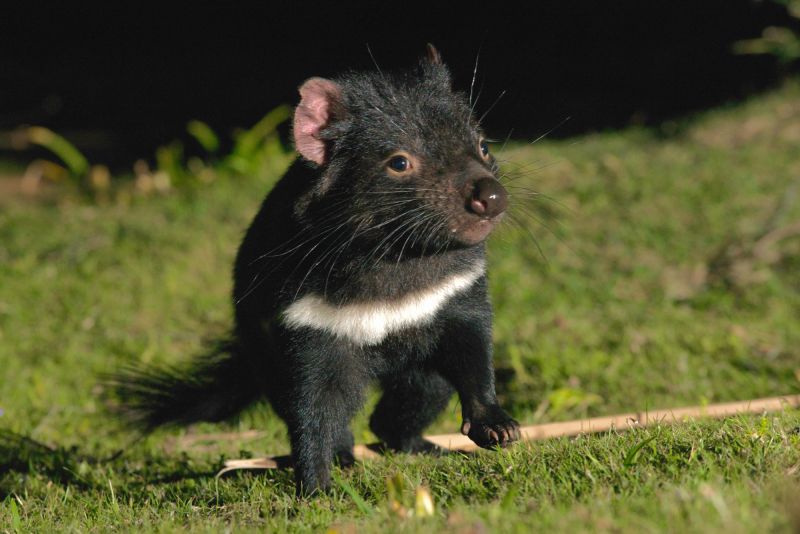
Image: A young Tasmanian Devil.
Do you have a favourite species?
I don't think that's fair! Do I have a favourite species that I really look forward to seeing? Let me think. Oh - my favourite bird - although reasonably common - is the Eastern Spinebill. I don't know what it is about the Eastern Spinebill, but I guess the look of it, the sleek bird with a beautiful hooked beak.
I do love going for a swim, and when you swim over a large Eagle Ray - that's actually quite scary, to be honest. To actually see how enormous these rays are, when you're swimming and see a dark mass passing below you and you think, wow that could give me a big hug if it wanted to!
When I go for a bit of a walk at night, I really love watching Eastern Bandicoots. They're very exotic to me still (being from Western Australia). I like that they do their own thing, they just ignore you!
In your time on Maria Island, have you noticed changes to the ecosystem?
Absolutely, yes! The biggest thing has been the introduction of the Tasmanian Devil. Before that, there was no large land predator on the island. I would actually describe it as a return to a more natural behaviour for many of the species. Animals are not hanging around campgrounds so much anymore and you do have to observe them in their wild state. You see cool things like the Cape Barron Geese, but they're no longer waddling around the campgrounds fighting each other - now they sleep in the creeks, so the devils can't disturb them while they're sleeping. There is a big difference between how animals are behaving now - which in this case is a good thing!
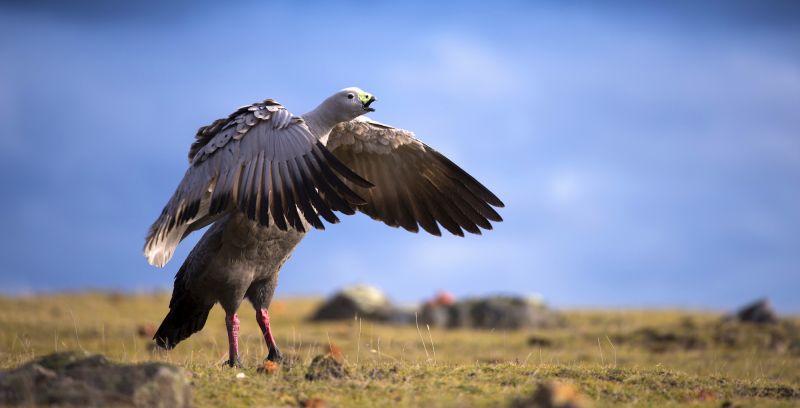
Image: One of the Island's many Cape Barron Geese.

